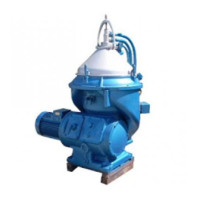15
2 Separation process 2.1 Basic principles
2.1 Basic principles
The purpose of separation can be:
• to free a liquid of solid particles.
• to separate two mutually insoluble liquids with
different densities, removing any solids at the
same time.
• to separate and concentrate solid particles
from a liquid.
2.1.1 Separation by gravity
A turbid liquid in a stationary vessel will clear
slowly as the heavy particles in the liquid mixture
are sinking to the bottom under the influence of
gravity. The lighter liquid phase will rise while the
heavier sinks.
Continuous separation and sedimentation can be
achieved in a settling tank having the outlets
arranged at levels suited to the density ratio of the
two liquid phases. Any solids and heavier
particles in the liquid mixture will settle and form a
sediment layer on the tank bottom.
2.1.2 Centrifugal separation
In a rapidly rotating vessel the gravity is replaced
by the centrifugal force, which can be thousands
of times greater. Separation and sedimentation
are continuous and very fast. When liquid and
solid particles in a liquid mixture are subjected to
the centrifugal force in a separator bowl, it takes
only a few seconds to achieve what takes many
hours in a tank under influence of gravity.
G0010711
Sedimentation by gravity
G0010821
Sedimentation in a settling tank, with outlets making it
possible to separate the lighter liquid parts from the
heavier
G0010921
The centrifugal solution

